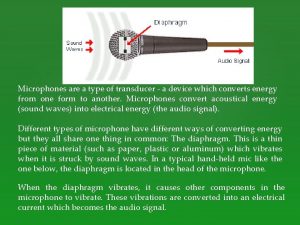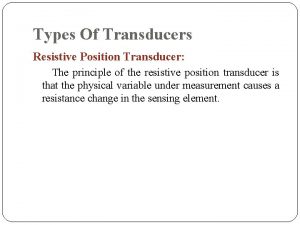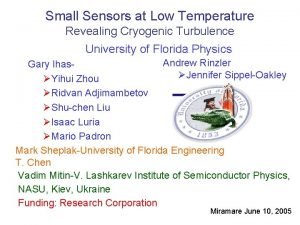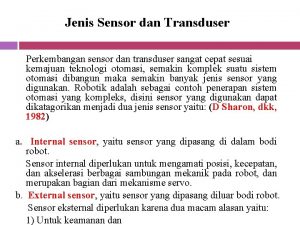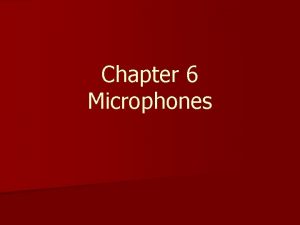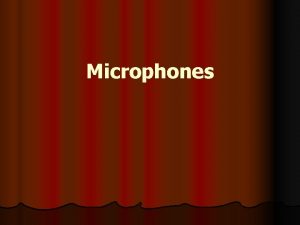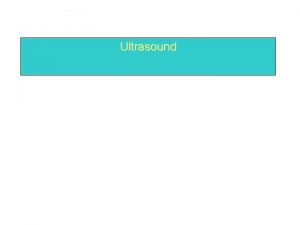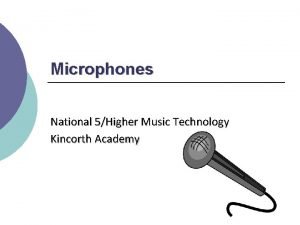Microphones are a type of transducer a device










- Slides: 10

Microphones are a type of transducer - a device which converts energy from one form to another. Microphones convert acoustical energy (sound waves) into electrical energy (the audio signal). Different types of microphone have different ways of converting energy but they all share one thing in common: The diaphragm. This is a thin piece of material (such as paper, plastic or aluminum) which vibrates when it is struck by sound waves. In a typical hand-held mic like the one below, the diaphragm is located in the head of the microphone. When the diaphragm vibrates, it causes other components in the microphone to vibrate. These vibrations are converted into an electrical current which becomes the audio signal.

Types of Microphone There a number of different types of microphone in common use. The differences can be divided into two areas: (1) The type of conversion technology they use This refers to the technical method the mic uses to convert sound into electricity. The most common technologies are dynamic, condenser, ribbon and crystal. Each has advantages and disadvantages, and each is generally more suited to certain types of application. The following pages will provide details. (2) The type of application they are designed for Some mics are designed for general use and can be used effectively in many different situations. Others are very specialized and are only really useful for their intended purpose. Characteristics to look for include directional properties, frequency response and impedance (more on these later).

Microphone parameters When choosing a microphone for any given application, it is necessary to take account of the various attributes, specifications and performance parameters that it has. Some of the key parameters for microphones include: Fidelity Sensitivity Frequency response Directional attributes Robustness Cost Convenience of use Appearance The importance of the different microphone parameters will depend upon the application. Before making a choice of any given microphone it is necessary to decide what is important.

Microphone features When looking at the optimum microphone for any given application, there are many different parameters and issues to consider. Some of the issues will include the following features: Type of microphone: There are very many different types of microphone that are available. Each type has its own characteristics and is best suited for particular applications. Directional characteristics: Microphones can have different sensitivity levels in different directions. The microphone directional characteristics are important in making sure the microphone used can pick up all the sounds that are needed. Accordingly the directional capabilities are of great importance and microphones are often characterized by them. Diaphragm size: Microphones with different diaphragm sizes have different characteristics and are therefore often used in different applications.

Some of the major types of microphone technology include: v Moving coil / dynamic microphone v Condenser microphone v Electret microphone v Ribbon microphone v Boundary microphone / PZM v Carbon microphone v Crystal / ceramic

This type of microphone is widely used for stage performances and many other applications. The moving coil microphone, has a small cone with a coil wound at its apex. This is held in a magnetic field and a current is induced in the coil as it moves in line with the sound vibrations.

The condenser microphone consists of a capacitor of which one plate is the microphone diaphragm. As sound waves hit the diaphragm, it vibrates and causes changes in capacitance. This can be converted into changes in voltage. The condenser microphone gains its name from the fact that when it was invented, capacitors were called condensers.

Microphone directional properties Microphones may also be categorized by their directional properties. The directional properties of a microphone are particularly important in many instances. Many have a directional response, like the popular cardioid response and this cuts out some extraneous noise. Omni directional microphones will pick up sounds from all directions. This enables the microphone to accept a variety of wanted sounds regardless of their direction, but increases the levels of background noise and also increases the possibility of acoustic feedback when used with public address systems.

Microphone diaphragm type Microphones may also be categorized according to the diaphragm size. The size of diaphragm can provide different characteristics, even for the same technology type of microphone. Accordingly sometimes microphones may be chosen for the type of diaphragm they use. When choosing the microphone for a given application, it is wise to check its overall response and tailor it to the type of sounds it is required for pick up.

1. When you speak, sound waves created by your voice carry energy toward the microphone. Remember that sound we can hear is energy carried by vibrations in the air. 2. Inside the microphone, the diaphragm (much smaller than you'd find in a loudspeaker and usually made of very thin plastic) moves back and forth when the sound waves hit it. 3. The coil, attached to the diaphragm, moves back and forth as well. 4. The permanent magnet produces a magnetic field that cuts through the coil. As the coil moves back and forth through the magnetic field, an electric current flows through it. 5. The electric current flows out from the microphone to an amplifier or sound recording device.

